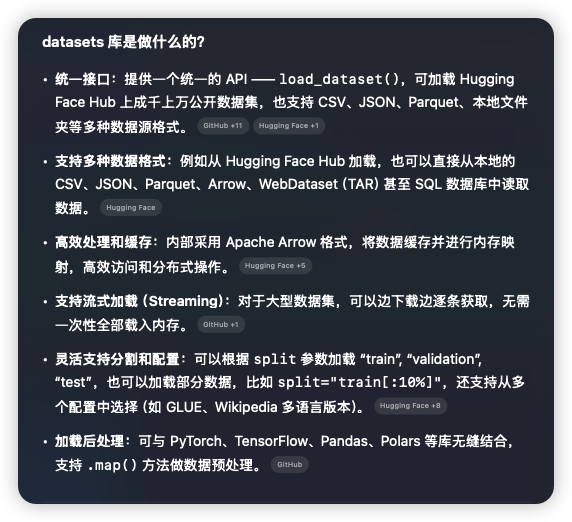本文最后更新于 118 天前(2025-08-19),部分内容可能已经过时。
- 数据导入 - 使用 TinyStories 数据集
- 数据分词 - 使用 tiktoken 进行 GPT-2 风格的分词
- 批次创建 - 为训练创建输入-输出批次
- 模型架构 - 实现了完整的 GPT 架构,包括:
LayerNormCausalSelfAttentionMLPBlockGPT 主模型类
- 损失函数 -
estimate_loss() 函数 - 训练配置 - 学习率、批次大小等超参数设置
- 优化器和调度器 - AdamW 优化器配合学习率调度
- 训练循环 - 完整的训练过程
- 可视化 - 损失函数曲线绘制
- 推理测试 - 模型生成文本的示例
数据导入#
用的数据集是 tinystory roneneldan/TinyStories · Datasets at Hugging Face
这是由 gpt 生成的
首先安装依赖后加载数据
依赖
这里我直接拿到的是 txt 文件。如果网络方便的话可以直接
1
2
3
| from datasets import load_dataset
# 导入数据,这里记得科学上网,否则无法在hf上下载数据集
ds = load_dataset("roneneldan/TinyStories")
|
所以我这边根据 C 老师的指导加载本地数据 以及 验证数据加载效果。代码如下
[python] 显示已折叠代码(57 行)
1
2
3
4
5
6
7
8
9
10
11
12
13
14
15
16
17
18
19
20
21
22
23
24
25
26
27
28
29
30
31
32
33
34
35
36
37
38
39
40
41
42
43
44
45
46
47
48
49
50
51
52
53
54
55
56
57
| from datasets import Dataset, DatasetDict
# 导入本地数据集
def load_local_dataset():
train_data = []
val_data = []
# 读取训练数据
with open('/data/yangr/yyai-slm/datasets/TinyStories-train.txt', 'r', encoding='utf-8') as f:
train_content = f.read()
# 按空行分割故事
stories = train_content.strip().split('\n\n')
train_data = [{'text': story.strip()} for story in stories if story.strip()]
# 读取验证数据
with open('/data/yangr/yyai-slm/datasets/TinyStories-valid.txt', 'r', encoding='utf-8') as f:
val_content = f.read()
# 按空行分割故事
stories = val_content.strip().split('\n\n')
val_data = [{'text': story.strip()} for story in stories if story.strip()]
# 创建数据集
train_dataset = Dataset.from_list(train_data)
val_dataset = Dataset.from_list(val_data)
return DatasetDict({
'train': train_dataset,
'validation': val_dataset
})
ds = load_local_dataset()
# 查看数据集的键(分割)
print("数据集分割:", list(ds.keys()))
print()
# 查看训练集和验证集的大小
print(f"训练集大小: {len(ds['train'])}")
print(f"验证集大小: {len(ds['validation'])}")
print()
# 查看数据集的特征(列)
print("数据集特征:", ds['train'].features)
print()
# 查看前几个样本
print("训练集前3个样本:")
for i in range(min(3, len(ds['train']))):
print(f"样本 {i+1}:")
print(ds['train'][i]['text'][:200] + "..." if len(ds['train'][i]['text']) > 200 else ds['train'][i]['text'])
print("-" * 50)
print("\n验证集前2个样本:")
for i in range(min(2, len(ds['validation']))):
print(f"样本 {i+1}:")
print(ds['validation'][i]['text'][:200] + "..." if len(ds['validation'][i]['text']) > 200 else ds['validation'][i]['text'])
print("-" * 50)
|
对数据集进行分词#
(1) 将数据集分词为 tokenIDs。
(2) 创建名为 “train.bin” 和 “validation.bin” 的文件,用于存储整个数据集的 tokenIDs。
(3) 我们确保 tokenIDs 存储在磁盘上,而不是内存中,以实现高效的计算。
[python] 显示已折叠代码(37 行)
1
2
3
4
5
6
7
8
9
10
11
12
13
14
15
16
17
18
19
20
21
22
23
24
25
26
27
28
29
30
31
32
33
34
35
36
37
| !pip install tiktoken
import tiktoken
import os
import numpy as np
from tqdm.auto import tqdm
enc = tiktoken.get_encoding("gpt2")
def process(example):
ids = enc.encode_ordinary(example['text']) # encode_ordinary 会忽略所有特殊令牌
out = {'ids': ids, 'len': len(ids)}
return out
if not os.path.exists("train.bin"):
tokenized = ds.map(
process,
remove_columns=['text'],
desc="tokenizing the splits",
num_proc=8,
)
# 将每个数据集中的所有 id 连接成一个大型文件,供训练使用
for split, dset in tokenized.items():
arr_len = np.sum(dset['len'], dtype=np.uint64)
filename = f'{split}.bin'
dtype = np.uint16 # (可以这样做,因为 enc.max_token_value == 50256 小于 2**16)
arr = np.memmap(filename, dtype=dtype, mode='w+', shape=(arr_len,))
total_batches = 1024
idx = 0
for batch_idx in tqdm(range(total_batches), desc=f'writing {filename}'):
# 将样本批量组合以加快写入速度
batch = dset.shard(num_shards=total_batches, index=batch_idx, contiguous=True).with_format('numpy')
arr_batch = np.concatenate(batch['ids'])
# 写入内存映射文件(mmap)
arr[idx : idx + len(arr_batch)] = arr_batch
idx += len(arr_batch)
arr.flush()
|
批次创建-为数据集创建输入-输出批次#
从整段 token 流(*.bin)里随机抽取 batch_size 个长度为 block_size 的连续片段作为输入 x,并把它们右移一位得到标签 y,用于下一个 token 的预测(next-token prediction)。
[python] 显示已折叠代码(15 行)
1
2
3
4
5
6
7
8
9
10
11
12
13
14
15
| def get_batch(split):
# 我们每个批次都重新创建 np.memmap,以避免内存泄漏
if split == 'train':
data = np.memmap('train.bin', dtype=np.uint16, mode='r')
else:
data = np.memmap('validation.bin', dtype=np.uint16, mode='r')
ix = torch.randint(len(data) - block_size, (batch_size,))
x = torch.stack([torch.from_numpy((data[i:i+block_size]).astype(np.int64)) for i in ix])
y = torch.stack([torch.from_numpy((data[i+1:i+1+block_size]).astype(np.int64)) for i in ix])
if device_type == 'cuda':
# 固定数组 x 和 y,使我们能够将它们异步地移动到 GPU(non_blocking=True)
x, y = x.pin_memory().to(device, non_blocking=True), y.pin_memory().to(device, non_blocking=True)
else:
x, y = x.to(device), y.to(device)
return x, y
|
